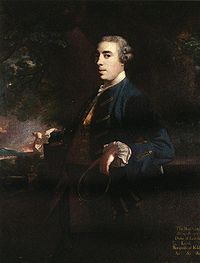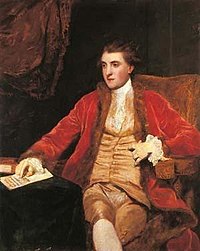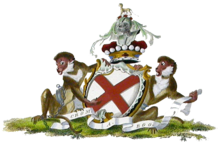Duke of Leinster
| Dukedom of Leinster | |
|---|---|
  | |
| Created by | George III |
| Peerage | Peerage of Ireland |
Duke of Leinster is a title in the Peerage of Ireland and the premier dukedom in that peerage. The subsidiary titles of the Duke of Leinster are: Marquess of Kildare (1761), Earl of Kildare (1316), Earl of Offaly (1761), Viscount Leinster, of Taplow in the County of Buckingham (1747), Baron Offaly (1620) and Baron Kildare, of Kildare in the County of Kildare (1870). The viscounty of Leinster is in the Peerage of Great Britain, the barony of Kildare in the Peerage of the United Kingdom, and all other titles in the Peerage of Ireland. The courtesy title of the eldest son and heir of the Duke of Leinster is Marquess of Kildare.
Earls of Kildare from 1316
This branch of the Welsh-Norman FitzGerald dynasty, which came to Ireland in 1169, were initially created Earls of Kildare. The earldom was created in 1316 for John FitzGerald. Two senior FitzGeralds, Garret Mór FitzGerald and his son, Garret Óg FitzGerald served as Lords Deputy of Ireland (the representative of the Lord of Ireland (the King of England) in Ireland). The tenth Earl, Thomas FitzGerald, known as Silken Thomas, was attainted and his honours were forfeit in 1537. In 1554, Thomas's half-brother and only male heir, Gerald FitzGerald, was created Earl of Kildare in the Peerage of Ireland. He was subsequently restored to the original Patent in 1569, as 11th earl. The second (1554-created) earldom became extinct in 1599, although the original earldom survived.
Dukes of Leinster from 1766
| Genealogy of Dukes of Leinster from 1766 : Premier Duke, Marquess, and Earl of Ireland[2] | |||||||||||||||||||||||||||||||||||||||||||||||||||||||||||||||||||||||||||||||||||||||||||||||||||||||||||||||||||||||||||||||||||||||||||||||||||||||||||||||||||||||||||||||||||||||||||||||||||||||||||||||||||||||||||||||||||||||||||||||||||||||||||||||||||||||||||||||||||||||||||||||||||||||||||||||||||||||||||||||||||||||||||||||||||||||||||||||||||||||||||||||||||||||||||||||||||||||||||||||||||||||||||||||||||||||||||||||||||||||||||||||||||||||||||||||||||||||||||||||||||||||||||||||||||||||||||||||||||||||||||||||||||||||||||||||||||||||||||||||||||||||||||||||||||||||||||||||||||||
|---|---|---|---|---|---|---|---|---|---|---|---|---|---|---|---|---|---|---|---|---|---|---|---|---|---|---|---|---|---|---|---|---|---|---|---|---|---|---|---|---|---|---|---|---|---|---|---|---|---|---|---|---|---|---|---|---|---|---|---|---|---|---|---|---|---|---|---|---|---|---|---|---|---|---|---|---|---|---|---|---|---|---|---|---|---|---|---|---|---|---|---|---|---|---|---|---|---|---|---|---|---|---|---|---|---|---|---|---|---|---|---|---|---|---|---|---|---|---|---|---|---|---|---|---|---|---|---|---|---|---|---|---|---|---|---|---|---|---|---|---|---|---|---|---|---|---|---|---|---|---|---|---|---|---|---|---|---|---|---|---|---|---|---|---|---|---|---|---|---|---|---|---|---|---|---|---|---|---|---|---|---|---|---|---|---|---|---|---|---|---|---|---|---|---|---|---|---|---|---|---|---|---|---|---|---|---|---|---|---|---|---|---|---|---|---|---|---|---|---|---|---|---|---|---|---|---|---|---|---|---|---|---|---|---|---|---|---|---|---|---|---|---|---|---|---|---|---|---|---|---|---|---|---|---|---|---|---|---|---|---|---|---|---|---|---|---|---|---|---|---|---|---|---|---|---|---|---|---|---|---|---|---|---|---|---|---|---|---|---|---|---|---|---|---|---|---|---|---|---|---|---|---|---|---|---|---|---|---|---|---|---|---|---|---|---|---|---|---|---|---|---|---|---|---|---|---|---|---|---|---|---|---|---|---|---|---|---|---|---|---|---|---|---|---|---|---|---|---|---|---|---|---|---|---|---|---|---|---|---|---|---|---|---|---|---|---|---|---|---|---|---|---|---|---|---|---|---|---|---|---|---|---|---|---|---|---|---|---|---|---|---|---|---|---|---|---|---|---|---|---|---|---|---|---|---|---|---|---|---|---|---|---|---|---|---|---|---|---|---|---|---|---|---|---|---|---|---|---|---|---|---|---|---|---|---|---|---|---|---|---|---|---|---|---|---|---|---|---|---|---|---|---|---|---|---|---|---|---|---|---|---|---|---|---|---|---|---|---|---|---|---|---|---|---|---|---|---|---|---|---|---|---|---|---|---|---|---|---|---|---|---|---|---|---|---|---|---|---|---|---|---|---|---|---|---|---|---|---|---|---|---|---|---|---|---|---|---|---|---|---|---|---|---|---|---|---|---|---|---|---|---|---|---|---|---|---|---|---|---|---|---|---|---|---|---|---|---|---|---|---|---|---|---|---|---|---|---|---|---|---|---|---|---|---|---|---|---|---|---|---|---|---|---|---|---|---|---|---|---|---|---|---|---|---|---|---|---|---|---|---|---|---|---|---|---|---|---|
The Most Noble Maurice (FitzGerald), 6th Duke of Leinster. (1887–1922).
Marquess and Earl of Kildare, co. Kildare, Earl and Baron of Offaly, all in the Peerage of Ireland; | |||||||||||||||||||||||||||||||||||||||||||||||||||||||||||||||||||||||||||||||||||||||||||||||||||||||||||||||||||||||||||||||||||||||||||||||||||||||||||||||||||||||||||||||||||||||||||||||||||||||||||||||||||||||||||||||||||||||||||||||||||||||||||||||||||||||||||||||||||||||||||||||||||||||||||||||||||||||||||||||||||||||||||||||||||||||||||||||||||||||||||||||||||||||||||||||||||||||||||||||||||||||||||||||||||||||||||||||||||||||||||||||||||||||||||||||||||||||||||||||||||||||||||||||||||||||||||||||||||||||||||||||||||||||||||||||||||||||||||||||||||||||||||||||||||||||||||||||||||||


The family was originally based in Maynooth Castle in Maynooth in County Kildare. In later centuries the family owned estates in Waterford with their country residence being a Georgian house called Carton House which had replaced the castle in County Kildare. In Dublin, the Earl built a large townhouse residence on the southside of Dublin called Kildare House. When the Earl was awarded a dukedom and became Duke of Leinster, the house was renamed Leinster House. One of its occupants was Lord Edward FitzGerald, who became an icon for Irish nationalism through his involvement with the Irish Rebellion of 1798, which ultimately cost him his life.
Leinster House was sold by the Leinsters in 1815. After nearly a century as the headquarters of the Royal Dublin Society, which held its famed Spring Show and Horse Show in its grounds, Oireachtas Éireann, the two chamber parliament of the new Irish Free State, rented Leinster House in 1922 to be its temporary parliament house. In 1924 it bought the building for parliamentary use. It has remained the parliament house of the Irish state.
The Dukes of Leinster had by the early 20th century lost all their property and wealth. Their Carton House seat was sold (though one of Ireland's most historic buildings with perfectly preserved 18th century grounds, it was controversially turned into a hotel and golf course in the late 1990s by the current owner in an act condemned by environmentalists),[citation needed] as later on was their other residence in Waterford. The family now live in a smaller property in Ramsden, Oxfordshire.
Title dispute
A controversial claim by the supposed descendants of the 5th Duke (largely debunked by Michael Estorick in 1981) was made and failed, with the Lord Chancellor accepting the claim made by the 9th Duke of Leinster.[3]
In 2006, a lawsuit was filed with HMG's Department of Constitutional Affairs by Theresa Pamella Caudill,[4] daughter of Eleanor and Maurice F. “Desmond” FitzGerald, on behalf of her nephew, a California builder, Paul FitzGerald, as claimant to be the rightful Duke of Leinster.[5] FitzGerald purported that he is the grandson of Lord Desmond FitzGerald, the second son of Gerald FitzGerald, 5th Duke of Leinster, who was recorded as having been killed in action during the First World War while serving with the Irish Guards. When Maurice FitzGerald, 6th Duke of Leinster died, mad and childless, in 1922, the Leinster dukedom [6] – and its considerable wealth and lands – devolved upon his youngest brother Lord Edward FitzGerald, who succeeded as the 7th Duke of Leinster. Paul FitzGerald and his supporters claimed that Lord Desmond faked his death and emigrated to California (by way of Winnipeg, Canada) where he lived until his death in 1967. It was further claimed by Mrs Caudill that a package of documents, witnessed by the Prince of Wales and Sir Edgar Vincent, Lord Feversham, had been lodged by her father with the Crown Office of the House of Lords in 1929, and the family had been denied access to them. Mrs Caudill believed the documents included evidence that her father agreed to relinquish the title for one generation but made it clear it was to be passed down to his son, her brother Leonard Fitzgerald. Instead, it was passed down through her father's brother's family. It was alleged that an archivist had acknowledged the package had once existed, but the official line was that it was now lost.[7]
The Baron Falconer of Thoroton, Lord Chancellor (2003–2007), and Harriet Harman, Minister of State in the Department for Constitutional Affairs, gave due consideration to this claim.[8] The claim was dismissed by Lord Falconer despite a 30-year campaign by Paul FitzGerald's family reputedly costing £1.3 million. The Lord Chancellor adjudicated that the title was to remain with the existing holder, the 9th Duke, Maurice FitzGerald. Paul FitzGerald has a right of appeal against the Lord Chancellor's verdict by petitioning Her Majesty The Queen, Elizabeth II.[9]
In 2010, however, DNA evidence was presented that indicates that Paul FitzGerald is related to the wife of the 5th Duke, the former Lady Hermione Duncombe.[1] As reported in The Scotsman, "with the help of Dunfermline-based genealogist Lloyd Pitcairn, Mrs FitzGerald Caudill [Paul FitzGerald's aunt] traced Maud Crawford, the grand-daughter of Lady Hermione's younger sister Urica [sic] Duncombe. The results of the tests found that it was '41 times more probable' that Ms Crawford and Paul FitzGerald were extremely closely related than were from different families. The evidence that Paul FitzGerald is related to the family of the 5th Duke's wife is the first DNA evidence ever produced in the case, and may support Mrs FitzGerald Caudhill's long-held claim suggesting that her mysterious father was the son of Lady Hermione, the wife of the fifth Duke of Leinster."[2]
It had also previously been alleged[10] that the 9th Duke′s grandfather, the 7th Duke, was the biological son of the Earl of Wemyss and March. Had this been proven then neither the present Duke, nor any other male descendant of the 7th Duke, would be a legitimate heir of the 1st Duke of Leinster.
Earls of Kildare (1316)

- Other titles: Lord of Offaly (c. 1193–?)
- John FitzGerald, 1st Earl of Kildare (1250–1316), already 4th Lord of Offaly, was rewarded for serving Edward I of England in Scotland
- Thomas FitzGerald, 2nd Earl of Kildare (died 1328), younger (only surviving) son of the 1st Earl
- John FitzGerald (1314–1323), eldest son of the 2nd Earl, died in childhood
- Richard FitzGerald, 3rd Earl of Kildare (1317–1329), second son of the 2nd Earl, died unmarried
- Maurice FitzGerald, 4th Earl of Kildare (1318–1390), third and youngest son of the 2nd Earl
- Gerald FitzGerald, 5th Earl of Kildare (died 1432), a son of the 4th Earl
- The 5th Earl had at least one son Thomas, who predeceased him
- John FitzGerald, 6th Earl of Kildare (de jure; d.c.1434), a younger son of the 4th Earl; he was forced to dispute his right to the title with a son-in-law of the 5th Earl
- Thomas FitzGerald, 7th Earl of Kildare (died 1478), son of the 6th Earl
- Gerald FitzGerald, 8th Earl of Kildare (c. 1456–1513), eldest son of the 7th Earl (Gearóid Mór FitzGerald)
- Gerald FitzGerald, 9th Earl of Kildare (1487–1534), eldest son of the 8th Earl (Gearóid Óg Fitzgerald)
- Thomas FitzGerald, 10th Earl of Kildare (died 1537), "Silken Thomas", eldest son of the 9th Earl, led an insurrection in Ireland and his honours were forfeit, and he died unmarried
- Other titles (11th–13th Earls): Earl of Kildare and Baron of Offaly (1554)
- Gerald FitzGerald, 11th Earl of Kildare (1525–1585), second son of the 9th Earl, was given a new creation in 1554 then restored to his brother's honours in 1569
- Gerald (Garrett) FitzGerald, Lord Offaly (1559–1580), eldest son of the 11th Earl, predeceased his father without male issue
- Henry FitzGerald, 12th Earl of Kildare (1562–1597), second son of the 11th Earl, died without male issue
- William FitzGerald, 13th Earl of Kildare (died 1599), third and youngest son of the 11th Earl, died unmarried
- Gerald FitzGerald, 14th Earl of Kildare (died 1612), elder son of Edward, himself third and youngest son of the 9th Earl
- Gerald FitzGerald, 15th Earl of Kildare (1611–1620), only son of the 14th Earl, died in childhood
- George FitzGerald, 16th Earl of Kildare (1612–1660), a son of Thomas, himself younger brother of the 14th Earl
- Wentworth FitzGerald, 17th Earl of Kildare (1634–1664), elder son of the 16th Earl
- John FitzGerald, 18th Earl of Kildare (1661–1707), only son of the 17th Earl, died without surviving issue
- Henry FitzGerald, Lord Offaly (1683–1684), only son of the 18th Earl, died in infancy
- Robert FitzGerald, 19th Earl of Kildare (1675–1744), only son of Robert, himself younger son of the 16th Earl
- Other titles (20th Earl): Viscount Leinster, of Taplow in the County of Buckingham (GB 1747)
- James FitzGerald, 20th Earl of Kildare (1722–1773) was created Marquess of Kildare in 1761
Marquesses of Kildare (1761)
- Other titles: Earl of Kildare (1316), Earl of Offaly (1761), Viscount Leinster, of Taplow in the County of Buckingham (GB 1747) and Lord of Offaly (c. 1193–?)
- James FitzGerald, 1st Marquess of Kildare (1722–1773) was created Duke of Leinster in 1766
- George FitzGerald, Earl of Offaly (1748–1765), eldest son of the 1st Marquess
Dukes of Leinster, second creation (1766)
- Other titles: Marquesse of Kildare (1761), Earl of Kildare (1316), Earl of Offaly (1761), Viscount Leinster, of Taplow in the County of Buckingham (GB 1747) and Lord of Offaly (c. 1193–?)
- James FitzGerald, 1st Duke of Leinster (1722–1773), elder son of the 19th Earl
- William Robert FitzGerald, 2nd Duke of Leinster (1749–1804), second son of the 1st Duke
- George FitzGerald, Marquess of Kildare (1783–1784), eldest son of the 2nd Duke, died in infancy
- Augustus Frederick FitzGerald, 3rd Duke of Leinster (1791–1874), second son of the 2nd Duke
- Other titles (4th Duke onwards): Baron Kildare (UK 1870)
- Charles William FitzGerald, 4th Duke of Leinster (1819–1887), eldest son of the 3rd Duke
- Gerald FitzGerald, 5th Duke of Leinster (1851–1893), eldest son of the 4th Duke
- Maurice FitzGerald, 6th Duke of Leinster (1887–1922), eldest son of the 5th Duke, died unmarried
- Edward FitzGerald, 7th Duke of Leinster (1892–1976), third and youngest son of the 5th Duke
- Gerald FitzGerald, 8th Duke of Leinster (1914–2004), only legitimate son of the 7th Duke
- Maurice FitzGerald, 9th Duke of Leinster (born 1948), elder son of the 8th Duke
- Thomas FitzGerald, Earl of Offaly (1974–1997), only son of the 9th Duke, died unmarried in a road traffic collision
The heir presumptive is the present holder's nephew Edward FitzGerald (born 1988), only son of Lord John FitzGerald (1952–2015)
Line of succession
- Edward FitzGerald (born 1988) (only son of Lord John)
- Peter Charles FitzGerald (born 1925) (grandson of Lord Charles FitzGerald, fifth son of the 4th Duke)
- Stephen Peter FitzGerald (born 1953) (only son of Peter FitzGerald)
Family Tree
Coat of arms

The coat of arms of the Dukes of Leinster derives from the legend that John FitzGerald, 1st Earl of Kildare, as a baby in Woodstock Castle, was trapped in a fire when a pet monkey rescued him. The FitzGeralds then adopted a monkey as their crest (and later supporters) and occasionally use the additional motto Non immemor beneficii (Not forgetful of a helping hand).[11] The motto "Crom A Boo" comes from the medieval Croom Castle and "Abu", meaning "up" in Irish; Crom Abu was the FitzGeralds' medieval warcry. Crom (Croom) and Shanet (Shanid) were two castles about 16 miles apart in Co Limerick, one being the seat of the Geraldines of Kildare, and the other that of the Geraldines of Desmond, whose distinctive war cries were accordingly “Crom-a-boo” and “Shanet-a-boo.” In 1495 an act of Parliament was passed (10 Hen. VII. C. 20) “to abolish the words Crom-a-boo and Butler-a-boo.” The word “Abu” or “Aboo,” an exclamation of defiance, was the usual termination of the war cries in Ireland, as in a' buaidh, "to victory!"[12] Saint Patrick's Saltire, a red saltire on a white field, may have been adapted from the Dukes arms on the 1783 creation of the Order of Saint Patrick, of which the 2nd Duke of Leinster was the senior founder member.
- Escutcheon: Argent a saltire gules.
- Crest: A monkey statant proper environed about the middle with a plain collar and chained or.
- Supporters: Two monkeys, environed and chained as in the crest.
- Motto: Crom a boo (Now it would be spelt "Crom Abu". In English, "Up Croom", or "Croom to victory."
Further reading
- Estorick, Michael (1981). Heirs & Graces: the Claim to the Dukedom of Leinster. Weidenfeld & Nicolson.
- Fitzgerald, Alan John (2004). Barons, Rebels & Romantics: the Fitzgeralds' First Thousand Years. 1stBooks Library.
- Dooley, Terence A M (2014). The decline and fall of the dukes of Leinster, 1872-1948 : love, war, debt and madness. Dublin: Four Courts Press. ISBN 9781846825330. OCLC 872987047.
See also
References
- ^ The peerage of England. 3 vols. in 4. Sig. N6,7 of vol. 1, 3B1 of vol. 2 ... - Arthur Collins - Google Books
- ^ Fox-Davies, Arthur Charles (1904) [1986]. The Art of Heraldry: An Encyclopædia of Armory. London: Bloomsbury Books. p. 485. ISBN 0-906223-34-2.
{{cite book}}: Unknown parameter|titlelink=ignored (|title-link=suggested) (help) - ^ Peterkin, Tom. Battle over Irish dukedom settled, Daily Telegraph, 21 April 2007. Accessed 12 June 2008.
- ^ "Theresa Caudill". Retrieved 2016-08-25.
- ^ Craig, By Olga. "DNA tests and a mystery package in the £1m battle just for a duke's title". Retrieved 2016-08-25.
- ^ British Dukes (Holding peerages granted by the Monarch) have Dukedoms; sovereign Dukes (continental rulers of territories without any overlord, i.e. the Grand Duchy of Luxembourg) have Duchies
- ^ Craig, By Olga. "DNA tests and a mystery package in the £1m battle just for a duke's title". Retrieved 2016-08-25.
- ^ A Californian claimant, an 'escape' from the trenches and the fight for a dukedom - website of The Daily Telegraph
- ^ American loses battle over Leinster dukedom claim - website IrishAbroad
- ^ Angela Lambert, Unquiet Souls (Harper & Row, 1984), page 64
- ^ Burke's Peerage and Gentry
- ^ Complete Peerage. (1890) Vol III. (D-F) p358 "Fitz-Gerald of Offaly".

